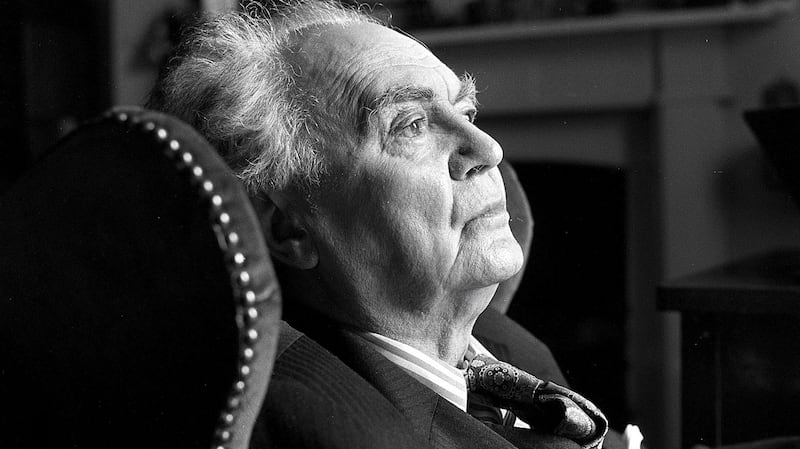A headless mannequin is wearing a black and white check silk dressing gown, one hand in its pocket and wedged into the fingers of the other is a black cigarette holder. It is the signature image of Noël Coward, whose voice wafts across the room singing Someday I'll Find You with his great collaborator Gertrude Lawrence.
Noël Coward: Art & Style, a new exhibition at the Guildhall Art Gallery until December 23rd, focuses on Coward’s visual style and on the costumes and décor created for his plays and films by some of his generation’s most celebrated artists and designers. But it also explores the way Coward created a public image that at once concealed who he was and enabled him to be himself.
The show was due to open last year to mark the 100th anniversary of his West End debut but was postponed due to coronavirus. Coward's first stage appearance came 10 years earlier, in a musical play called The Goldfish, written and produced by Lila Field.
While Coward pursued success from the start in the most single-minded way, Mac Liammóir discovered Yeats and the <a href="http://cms-live-p-service.irish-times.ie:8080/preview/www/2.789/2.4171/7.1213540?article=true&tag_organisation=Celtic" polopoly:contentid="7.1213540">Celtic</a> revival, [and] moved to Dublin
Also making his stage debut was another 10-year-old, Alfred Willmore, who later became Micheál Mac Liammóir, who asked Coward what he wanted to be when he grew up.
“An actor, of course,” he said.
“Why, what do you want to be?”
Mac Liammóir claimed later that his ambition at the time was to be a draper's assistant in the Munster Arcade, a department store in Cork, where he pretended to have been born. In fact, both boys grew up in what Coward described as "genteel poverty" in suburban London and both were determined to escape.
They appeared together again as child actors in Peter Pan and remained in touch throughout their lives but Mac Liammóir described Coward as his oldest and "not among my dearest, but certainly among my nearest" friends.

“The bond between Noël Coward and myself is at once slight and profound like that among kinsmen who share an old tradition and a heritage as of some secret, seldom-spoken language between them: what jungle of professional childish memories had we not staggered and swaggered and danced and wept through together? The violent severing of our two paths after the age of fourteen seemed at moments to underline this atavistic tie,” he wrote in An Oscar of No Importance, one of his memoirs.
Coward and Mac Liammóir shared much more than their early professional background. Both were driven by an exceptional work ethic, both were writers as well as actors and each had other skills too, Mac Liammóir a designer and Coward a songwriter, singer and director. And both were gay in the decades after the trial of Oscar Wilde had hardened British attitudes towards homosexuality.
But while Coward pursued success from the start in the most single-minded way, Mac Liammóir discovered Yeats and the Celtic revival, moved to Dublin and travelled across Europe before he and Hilton Edwards began their life's work at the Gate Theatre.
“He had kept to the shining road of his earliest choice and never had shirked for a single day or night the incessant toil or the social turmoil it demanded,” Mac Liammóir wrote.
“I had wandered here and there in mind and in body as the mood of the moment suggested, living in improbable places, following a wavering, unpopular star through a series of incongruous images. But we had both emerged in many ways the same two people who had rehearsed and played together in The Goldfish at the age of ten and in Peter Pan at the age of twelve.”
Alternative vision
Coward overcame the barriers of class and sexuality by constructing a persona that was glamorous, humorous, carefree and louche and offering an alternative vision of masculinity that could be camp and transgressive but was also accessible to a mass audience. Mac Liammóir invented a biography as an Irishman with such commitment that he spoke, acted and wrote in Irish.
Coward had a 30-year relationship with the South African actor Graham Payn, while Mac Liammóir's relationship with Edwards lasted 50 years. Both Coward and Mac Liammóir had other, subsidiary romantic relationships and both created families of friends.
In the early 1960s, Mac Liammóir had a temporary falling out with his sister, during which she told him that, like many creative people, he had persuaded himself that the stories he had invented about himself were true. He replied that there was more truth in the life he had created and the persona he had invented than there could ever have been if he had remained tethered by his background and the attitudes of the age.





